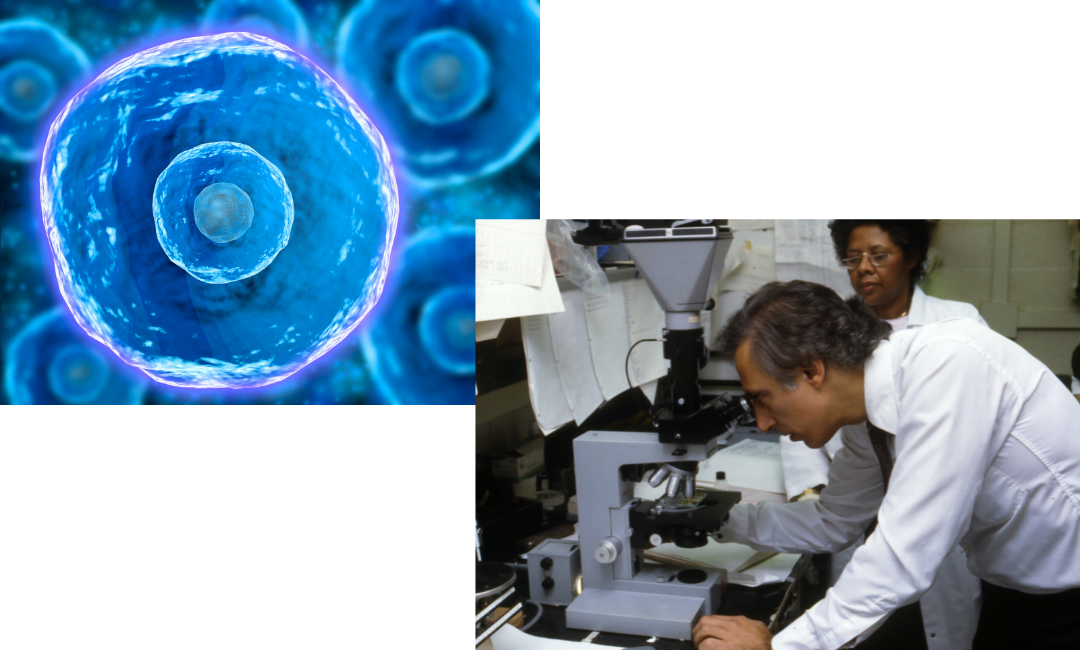
Our precise focus in B-cell malignancies
B-cells are a type of white blood cell (B-lymphocyte) that are part of the immune system and play an important role in fighting infection in the body.[1] Usually, the body makes new lymphocytes only when they are needed to replace old cells that have died. In B-cell malignancies, these cells malfunction, and become malignant. This means they grow when the body doesn’t need them and reproduce at an abnormal rate.[2]
B-cell malignancies can broadly be categorised into Hodgkin and non-Hodgkin lymphomas.[3] There are many different types, each with distinct characteristics, behaviours and treatment approaches, and each person’s experience with the disease is unique. While much progress has been made over the past decade, we remain focused on continuing to develop new treatment options with reduced side effects that can improve quality of life and prolong the duration of remission for all patients with these complex blood cancers.

At Janssen, we are focused on five main types of B-cell malignancy:

Chronic lymphocytic leukaemia (CLL)
-
CLL is generally a slow-growing blood cancer, in which the bone marrow makes too many white blood cells (B-lymphocytes).[4]
-
CLL patients usually don’t have any symptoms for at least a few years, but over time the cells grow and spread to other parts of the body, including the lymph nodes, liver, and spleen.[4][5][6]
-
While a rare cancer, CLL is the most common leukaemia in adults. In 2019, there were approximately three cases per 100,00 people in Central Europe.[7]
-
CLL is predominantly a disease of the elderly, with a median age of 72 years at diagnosis.[8]

Mantle Cell Lymphoma (MCL)
-
MCL is typically an aggressive, rare form of non-Hodgkin lymphoma that develops from abnormal white blood cells (B-lymphocytes). It is called ‘mantle cell’ because the abnormal lymphocytes come from an area called the ‘mantle zone’ in lymph nodes.[9]
-
The abnormal lymphocytes start to collect in the lymph nodes or body organs. They can then form tumours and begin to cause problems within the lymphatic system or the organ where they are growing.[10]
-
The average incidence rate in Europe is one to two cases per 100,000 people and the median age at diagnosis is approximately 65 years.[11]

Waldenström’s Macroglobulinemia (WM)
-
WM is another rare type of non-Hodgkin lymphoma, affecting two types of B-cells: lymphoplasmacytoid cells and plasma cells.[12]
-
WM is characterised by having high levels of an antibody known as immunoglobulin M (IgM). The build up of this protein causes excessive blood thickening which effects the flow of blood, especially through smaller blood vessels.[13]
-
Incidence rates in Europe are approximately one case per 102,220 people per year (2020) and the median age at diagnosis is 72 years.[14]

Diffuse Large B-cell lymphoma (DLBCL)
-
DLBCL is the most common type of non-Hodgkin lymphoma.[15]
-
It is a fast-growing type of lymphoma that develops from abnormal B-cells.[15]
-
These abnormal cells are larger than normal, healthy B-cells and are spread out (diffuse) rather than grouped together when they’re examined under a microscope.[15]
-
DLBCL has an incidence rate of approximately 3.8 new cases per 100,000 people per year (2015) across Europe, with a median age at diagnosis of 70 years.[16][17]

Follicular Lymphoma (FL)
-
FL is a common type of non-Hodgkin lymphoma that is generally slow-growing and develops from abnormal B-cells.[18]
-
It is called ‘follicular’ lymphoma because the abnormal B-cells usually develop in clumps called ‘follicles’ inside lymph nodes.[18]
-
FL has an estimated incidence of one to five new cases per 10,000 per year (2024) in Europe with a median age at diagnosis of 60-65 years.[18][19]

Our approach to research
A better understanding of disease biology and the emergence of newer generation therapies has led to clinical outcomes greatly improving for many patients living with certain types of B cell malignancies over the last decade.[20][21][22] We are proud to have contributed to this innovation by delivering first-in-class targeted treatment regimens that provide patients and physicians with non-chemoimmunotherapy options for use in treating CLL, MCL and WM.
However, unmet medical needs remain,[23] and we are committed to building on our progress in this area through a comprehensive clinical development programme. By deepening our understanding of these complex forms of blood cancer and taking a patient-focused approach, we’re striving to deliver the next wave of innovations that are tailored to patient’s individual needs and preferences.
With this in mind, we are steadfast in our commitment to stay in front of cancer, moving towards a future where treatment-free remissions and cures are not just conceivable, but increasingly within reach.
Follow Us
CP-301675


